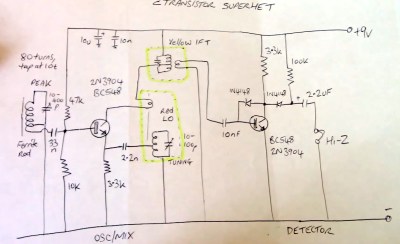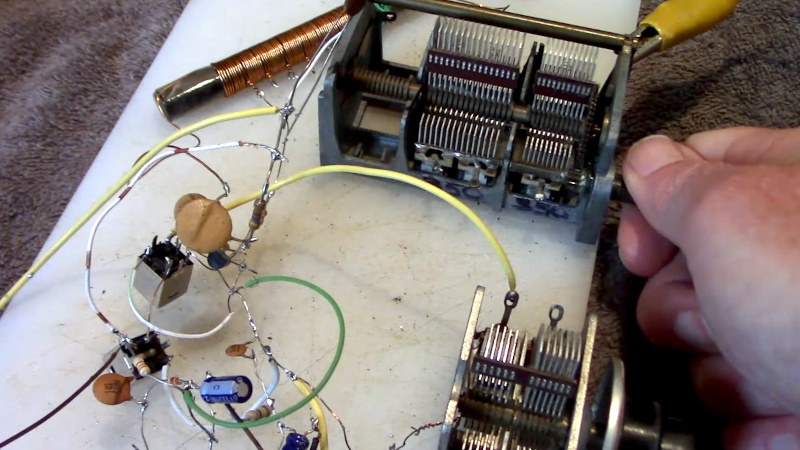If you cultivate an interest in building radios it’s likely that you’ll at some point make a simple receiver. Perhaps a regenerative receiver, or maybe a direct conversion design, it’ll take a couple of transistors or maybe some simple building-block analogue ICs. More complex designs for analogue radios require far more devices; if you’re embarking on a superhetrodyne receiver in which an oscillator and mixer are used to generate an intermediate frequency then you know it’ll be a hefty project. [VK3YE] is here to explode that assumption, with a working AM broadcast band superhet that uses only two transistors.

A modern portable radio will almost certainly use an all-in-one SDR-based chip, but in the golden age of the transistor radio the first stage of the receiver would be a single transistor that was simultaneously RF amplifier, oscillator, and mixer. The circuit in the video below does this , with a ferrite rod, the familiar red-cored oscillator coil, and a yellow-cored IF transformer filtering out the 455 kHz mixer product between oscillator and signal.
There would normally follow at least one more transistor amplifying the 455 kHz signal, but instead the next device is both a detector and an audio amplifier. Back in the day that would have been a germanium point contact diode, but now the transistor has a pair of 1N4148s in its biasing. We’re guessing this applies a DC bias to counteract the relatively high forward voltage of a silicon diode, but we could be wrong.
We like this radio for its unexpected simplicity and clever design, but also because he’s built it spiderweb-style. We never expected to see a superhet this simple, and even if you have no desire to build a radio we hope you’ll appreciate the ingenuity of using simple transistors to the max.
















Simple if you can source the now overpriced varicaps and IF transformers. It’s been years since there was anything containing these that I would have been able to scrap for them.
Hi, variable capacitor, I guess. An DIY substitute can be made at home, in principle.
By varicap, the variable capacity diode is often being associated to.
The small transformers with the iron core on a screw are hard to get by, I agree.
A lot simpler if the static circiit diagram and build is not presented as a video.
yeah the good part of the article is the screencap of the schematic :)
I recall a regenerative superhet project that was in a 70’s era Boy Scout Radio Merit Badge handbook.
In this project, the first stage after the amplifier was a regenerative detector.
Nice video and a very good minimalist demonstration of what can be done with very few components. Earl “Madman” Muntz would have been proud–no need to “Muntz” that radio with his diagonal cutters!
73!
Depends on the oscillators and whether you want the thing to be frequency-agile. I’ve seen random configurations of inductors and some corrosion spontaneously receive strong local stations, so while not necessarily being het, I think it can be done minimally.
As someone else mentioned, variable capacitors are quite expensive nowadays (when you can find them), because we just dont use them anymore for anything…
The big models are nolonger common,
but can sometimes be bought in specialized ham radio shops or antique radio shops.
Radio amateurs still have a need them for tuning of magnetic loop antennas or building linear amplifiers.
As for variable capacitors themselves,
the small plastic type in a white or translucent chassis is still available (more or less).
It’s the 500 pf type, with some smaller extra pins for 47 pf, 16 pf etc.
They were used in pocket radios.
https://commons.wikimedia.org/wiki/File:Universum_UR_1886_-_tuner_part_-_variable_capacitor-2252.jpg
A few decades ago, the 500 pf models in a “Pertinax” hard paper chassis were still widely available.
They were commonly used for detector receivers (crystal radios).